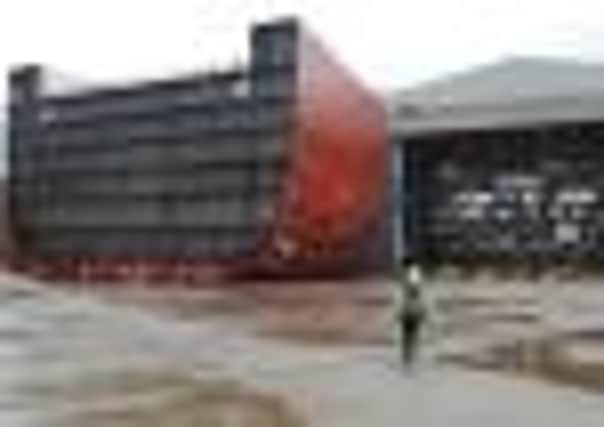Giant of the seas HMS Queen Elizabeth begins to take shape


Under a leaden sky yesterday, one half of the giant hull sections of the navy’s new aircraft carrier was rolled out of the fabrication shed on 132 powerful remote-controlled rollers. In an operation that took more than 90 minutes, the 4,000 tonnes of steel was carefully manoeuvred 100 metres until all eight floors of Block M/N, as it is known, were perfectly aligned with its sibling, Block P/Q/R/S.
By mid-afternoon, they were but inches apart.
When finally welded together over the next few weeks, the two blocks will comprise the 11,500-tonne aft section of the aircraft carrier and measure 80m.
Advertisement
Hide AdAdvertisement
Hide Ad

By November, the section will have been fitted with two main engines, a medical area and living accommodation, at which point it will be floated into the Clyde and then towed on a 600-mile route around the north of Scotland to Rosyth shipyard in Fife, where the completed ship will be fitted together.
Project director Steven Carroll said workers had reached a “major milestone” in the construction.
He said HMS Queen Elizabeth and its sister ship, HMS Prince of Wales, were “the largest and most powerful warships we’ve ever built for the Royal Navy”.
He added: “They are 65,000 tonnes, so about three times the size of our present Invincible class and these ships will be the flagships for the nation for years to come.


“It’s another chapter in a rich history of shipbuilding on the Clyde and it’s a major engineering endeavour and one that we should be proud of, as a nation, that we can deliver major and complex programmes in the way that we are at the moment.”
The distance from keel to masthead is 56 metres, or four metres taller than Niagara Falls, while the vessel’s massive propellers weigh 33 tonnes each and are one and a half times as high as a double-decker bus. By the time the ship is launched, it will have been covered in 1.5 million square metres of paint, the equivalent of painting Hyde Park in London.
Mr Carroll said up to 14,000 people were working on the project, in terms of the construction, design and manufacturing and supply of materials.
The ship is due to be completed by 2016, with HMS Prince of Wales following later. The ships are being delivered by the Aircraft Carrier Alliance, a partnership between BAE Systems, Thales UK, Babcock and the Ministry of Defence.
Advertisement
Hide AdAdvertisement
Hide AdThe two carriers have been dogged by controversy. During the recent defence review it was suggested that, instead of building both, the government would cancel one, but BAE Systems said the consequence would by the closure of their Clyde shipyard.
Although the coalition government decided to press on with both ships, it has not yet been decided whether to sell one on completion or have it remain in a state of “extended readiness”, effectively mothballed.
Meanwhile, the cost of the two has doubled to £7 billion.